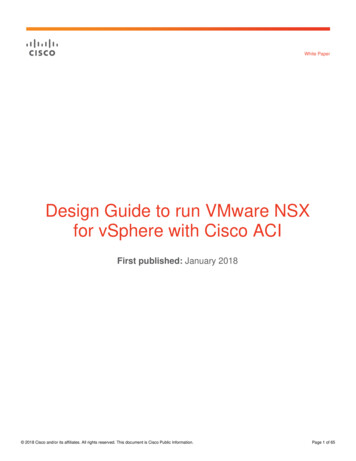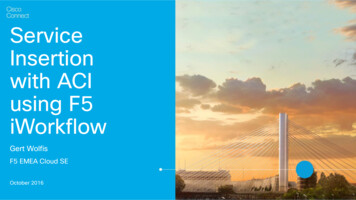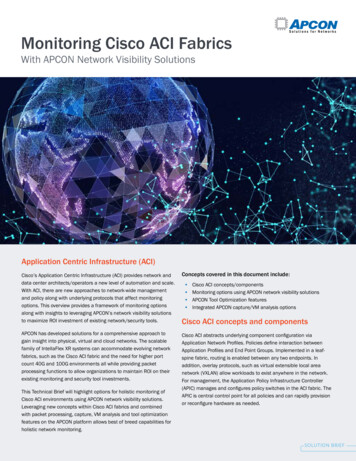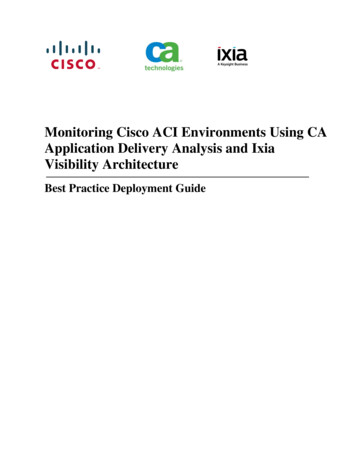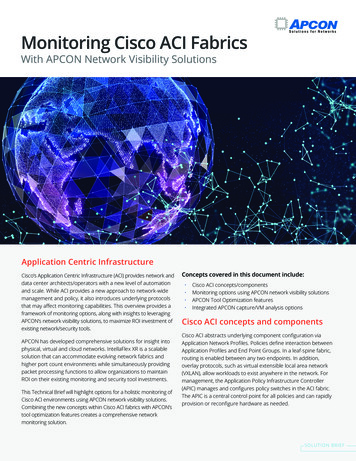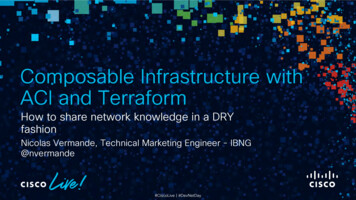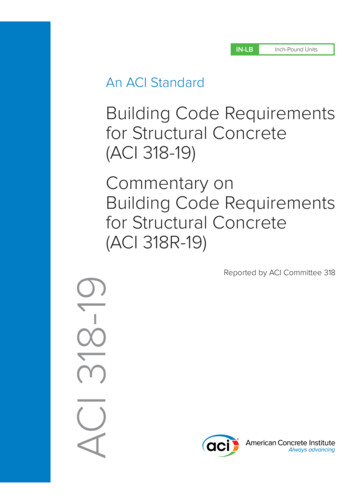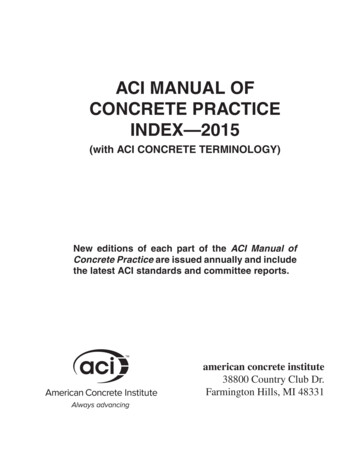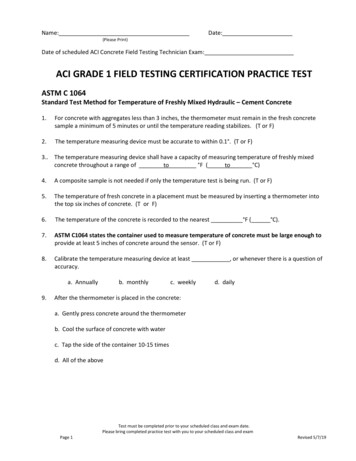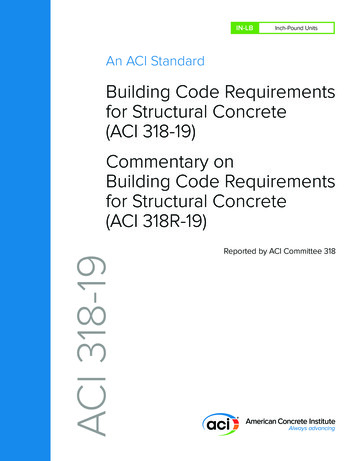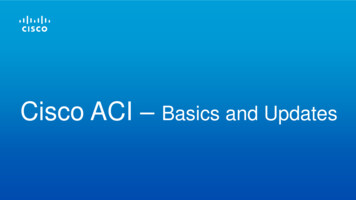
Transcription
Cisco ACI – Basics and Updates
Market Momentum Continues6,000 Nexus 9K and ACICustomers GloballyNEW1400 50ACICustomersEcosystemPartnersECOSYSTEM
Cisco Data Center StrategyDefined by Applications. Driven by Policy. Delivered as a Service / pute& StoragePolicyCloudBUSINESS OUTCOMESEfficiencySpeedDigitization
Foundational Switching Platforms for the Next DecadeNexus 9000Industry Leading Price/Performance, Port Density:Fastest 10G/25G/40G/50G/100G Platform1/10/40/100G10110010Programmability/ Open APIs: Linux Containers, Python,Power Shell, Puppet, Chef Ideal for DevOps!!15% Better Power & Cooling–2.8X Better ReliabilityInnovation Object Model, No Backplane,No Midplane, Health scoresStandalone / ACI Ready Multi-million Savings 40/100G on Existing Cablesusing BiDi Optics. Non disruptive migration to 40G
What problemare we solving?
Now let’s imagine a network switch at the moment, largely configured on the CLI
All nodes are managed and operated independently,and the actual topology dictates a lot of configuration Device basics: AAA, syslog, SNMP, PoAP, hashseed, default routing protocol bandwidth Interface and/or Interface Pairs: UDLD, BFD,MTU, interface route metric, channel hashing,Queuing, LACP, Fabric and hardware specific design: HWTables, TCAM, Switch Pair/Group: HSRP/VRRP, VLANs, vPC,STP, HSRP sync with vPC, Routing peering,Routing Policies, Application specific: ACL, PBR, static routes,QoS, . Fabric wide: MST, VRF, VLAN, queuing,CAM/MAC & ARP timers, COPP, route protocoldefaults
Cisco ACI solves the problem Interfaces, protocols, TCAM, etc all represented in an object model, andALL accessible through an XML/JSON API and CLI
APIC becomes single point of management forthe entire fabric with a policy-based model
and the fabric acts like a single (virtualized) switch
Adding, removing or replacing nodesbecomes extremely simple
And so do network upgrades
and you get best troubleshooting with fullphysical, virtual and services visibility
So, the first thing toremember about ACI: it isa programmable physicalfabric with a single point ofmanagement
Overview of the ACI FabricAPIC ControllerIndustry’s most efficient fabric:- 220k 1/10Gb edge hosts- High-density 40/100G spine- 1 million IPv4 / IPv6endpoints- 64,000 tenantsACI Spine NodesACI Leaf NodesACI FabricACI Fabric Features ACI Spine Layer – Provides bandwidth and redundancy between Leaf NodesACI Leaf Layer – Provides all connectivity outside the fabric - including servers, service devices, other networksOptimized Traffic Flows – Accommodates new E-W traffic patterns in simple, scalable, non-blocking designDecoupling of Endpoint Identity – Network policies automatically move with VM/Server/ContainerNetwork Innovations – Dynamic load balancing, dynamic packet prioritization, congestion management
ACI Operational Simplicity
ACI – Day 2 Tools for Simplified OperationsSystem HealthScoresEndpointTrackerStatistics PerAppReal-timeHeat MapsContractDeny LogsEndpointTroubleshootingWizard
ACI Policy Model
Policy Defined by sh configurations automatically to the entire network
The ACI Policy ModelTenant VDCVRF VRFContracts Access ListsBridge Domain Subnet/SVIEnd Point Group Broadcast Domain/VLANPrivate VLANEPG1EPG2Any-AnyReplicates aTraditional SwitchL2 External EPG 802.1q TrunkL3 External EPG L3 Routed Link
The ACI Policy Model – Network Centric ConfigurationTenantGlobal VRF/Routing Table and ProtocolAny-Any ContractVLAN 10VLAN20BDBDVLAN 30 BD10.10.10.1/2410.10.20.1/2410.10.30.1/24VLAN 10VLAN20EPGEPGVLAN 30 EPGAny-Any Contract
The ACI Policy Model – Network Centric ConfigurationTenantGlobal VRF/Routing Table and ProtocolVLAN 10 BDVLAN 20 BDVLAN 30 BD10.10.10.1/2410.10.20.1/2410.10.30.1/24ConnectTo ExternalSwitchL2 External(802.1q Trunk)VLAN 10 EPGVLAN 20 EPGVLAN 30 EPGL3 External(Routed Interface)Any-Any ContractAny-Any Contract
Advanced ACI Policy Model – Micro SegmentationApp 1 Database TierEPGApp 1 Web Tier EPGApp 1 App Tier EPGOnly SQLOnly HTTP(REST)Application ProfileOnly HTTPL2/L3External
Advanced ACI Policy Model – Service InsertionAppApp1 -1 App Tier EPGDatabaseTo DBTier EPGOnly SQLApp 1 Web Tier EPGL2/L3ExternalOnly HTTP (REST)Only HTTP (REST)Automate IPS Load BalancerInsertionAutomate Firewall Load BalancerInsertionApplication Profile with Service Graphs
Software
Cisco ACI 1.2 ReleaseInfrastructure IP-based endpoint group (EPG) Shared Layer 3 outside (L3Out)connectivity Direct server return Common pervasive gateway for IPv4 andsecondary IP address for IPv4 ‘Multi-site Application’ – ACI Toolkit Service Insertion and Chaining for AnyLayer 4-7 device (no device package) Ingress policy enforcement for L3Outscalability Class of Service Preservation VXLAN support (host to ACI Fabric) Static Route with WeightsVirtualization VMware vSphere 6.0 support Basic GUI and Advanced GUI modesenhancements (vMotion for X-vCenter, X Simple Network Management ProtocolVDS)(SNMP) support for APIC Micro-segmentation Accurate counter and SNMP MIB support Microsoft Hyper-Vfor Layer 3 (L3Out) interface Cisco Application Virtual Switch (AVS) Troubleshooting wizard enhancementsfor IPv6 Cisco NX-OS style command-line Authentication, authorization, andinterface (CLI) on APICaccounting (AAA) for L4-L7 services Configuration rollback VMware vRealize integration Endpoint tracker New OpFlex for Open Virtual Traffic mapSwitch (OVS)‐Local policy enforcement‐Virtual Extensible LAN (VXLAN) support‐Network Address Translation (NAT) andfloating IP address‐Cisco Application Infrastructure Controller(APIC) GUI integration TLS 1.2 Cisco Nexus 9516 Switch(support for 10 slots)Troubleshootingand Operations
IP-Based EPGDescription This feature allows detailed EPG derivation based on the IP addressof the endpoint. Available for both physical and virtual endpoints.Use Case Directly attached storage filers: Many enterprises use storage filersthat expose one MAC address and many different IP addresses, andthey want to apply policy per IP prefix. A Cisco 9300 E-Series leafswitch or module is required.Matching Criteria IP address attribute: IP-prefix based‐ The IP address is specified in the Prefix/Subnet format: for example,1.1.1.0/30.‐ A longest prefix match is performed for the IP address to derive the EPG. MAC address attribute (future)‐ The exact and complete MAC address must be specified as a part ofthis policy.
IP-Based EPG: Use Case 1Shared Storage for Each CustomerDifferent security policyis needed for logicalstorage that uses thesame VLAN and sameMAC address butdifferent IP address.VLAN 10StorageESXiStorage for Customer A192.168.1.1Storage for Customer B192.168.1.2ESXiServers for Customer AESXiESXiServers for Customer B
Sharing VRF and L3Out Among TenantsBridge Domain, Subnet, and L3Out Under Tenant CommonDynamic protocolStatic ebAPPC 8.101.1/24No overlapping IP addresses among tenants, VRF instances shared among tenants, and traffic isolation through contractBridge domain and subnet and L3Out defined under tenant commonEPG, contract, and application profile under individual tenantsDynamic routing protocol with external routers
Sharing L3Out Across VRF Instanceswith Cisco ACI 1.2(x)Tenant 1VRF1ExternalEPG 1(Provider orConsumer)EPG(Consumer)L3Out 1Tenant-CommonVRF-CommonTenant 2L3Out SharedExternal EPG(SharedService Provider)VRF2ExternalEPG 2(Provider orConsumer)EPG(Consumer)L3Out 2ConsumerConsumeror Provider Shared service provider is an external EPG. Shared service provider can be in any tenants.ProviderProvideror Consumer
Shared Service with L3Out AcrossVRF InstancesTenant 1VRF1ExternalEPG 1(Shared ServiceConsumer)EPG(Consumer)L3Out 1Tenant 3VRF 3Tenant 2VRF2ExternalEPG 2(Shared ServiceConsumer)Shared ServiceEPG (Provider)External EPG 3L3Out 3EPG(Consumer)ConsumerL3Out 2Consumeror Provider Shared service provider is tenant EPG. External EPGs of different tenant and VRF access to shared services.ProviderProvideror Consumer
Virtualization
VMware vSphere 6.0 No changes in Cisco APIC configuration and operations A new VMware DVS Release 6.0 is added to force configuration toDVS to Release 6. Support for inter-data center and intra-vCenter Both vCenters should be part of thesame single sign-on (SSO) instance. Long-distance vMotion is not verified or supported. Support applies only to DVS, notCisco Application Virtual Switch. For more information, vSPHRWhats-New-6-0-PLTFRM.pdf. For a demonstration, .php?RCID 79b6da87533c4eac85dcedc8eaa5ac85.
Attribute-Based EPGDescription This feature allows detailed EPG derivation based on various virtualmachine attributes such as virtual machine name, guest OS, MACaddress, and IP address. Prior to Brazos, this feature was available for virtual endpointsattached with the Cisco AVS distributed virtual switch (B release).It is not available with VMware DVS. Available with 1.3 with EXswitches! Brazos also adds this feature for Cisco ACI and Microsoft SCVMMNote: This feature does not provide an intra-EPG security policy.Use Case Isolate malicious virtual machines. Create security across zones.Benefits Without changing the port-group association of servers, additionalsecurity and segmentation can be provided.
Use Case 1Isolate Malicious Virtual MachinesWebWeb01LinuxWeb02LinuxWeb03WinWindows inuxDB03WinXCriterionAttribute(OS Windows) Problem: A vulnerability is detected in a particular type of operating system (for example, Microsoft Windows).The network security administrator wants to isolate all Windows virtual machines. Solution: Define a security EPG with a criterion such as Operating System Windows. No contracts areprovided or consumed by this EPG. It will stop all inter-EPG communication for the matching virtual machines. No virtual machine attachment or detachment or placement in a different port group is needed.
Use Case 2Security Across buteAppApp01App02App03XSales-WebDB(virtual machine namecontains HR)CriterionAttributeDB01DB02DB03(virtual machine namecontains Sales) Problem: Virtual machines belonging to different departments (for example, HR and Sales) or different roles (for example,Production and Testing) are placed in the port group. But isolation across departments is required (for example,HR-Web-VM should not be able to talk to Sales-Web-VM). Solution: Define EPGs that match if the virtual machine name contains a matching string (for example, HR or Sales). Each attribute-based EPG can have its own security policies.
Service Insertion for Any Layer 4-7 device(No device package)Description Unmanaged L4-L7 devices to be used as service node in a service graph between EPGs.This approach allows the network team to handle the network automation part for the service devices with Cisco APIC. However, configurationand management can continue to follow their current model.This approach also helps those L4-L7 devices for which a device package is not available.1: Configure Cisco ACI fabric forL4-L7 service appliance – networkpart only.2: Administrator configures L4-L7service appliance in the usual way(CLI or GUI).L4-L7 Admin
Service Graph with “Unmanaged” DeviceUI hides all othersettings related to thepackage, configurationparameters, andconnectivity when themanaged mode isnot selected.
Simplified L4-L7Managed and unmanaged devices can be combined in a single graph.
Troubleshootingand Operations
Basic GUI
Basic GUI The Basic GUI mode shows only the most commonly used features and emphasizes ease of use. Some features are simply not exposed: L4-L7 integration, advanced routing (L3Out), etc.
Purpose of the Basic GUIWith the Cisco ACI 1.2 release, Release 1.2(x), Cisco ACI introduces analternative user interface to the existing GUI.The goals of this GUI are as follows:Reduce the time needed for deployment: Shorten the time needed to test Cisco ACI Provide ease of use in implementing Cisco ACIReduce the need for new learning: Provide network engineers with configurations based on current and traditional networking concepts (ACLs, VLANs,subnets, etc.) as much as possibleSwitching back and forth between the Advanced and Basic GUIs isnot recommended.Address the markets for specific customers: Provide a tool for commercial customers Simplify the most common operations
Main Differences Between Basic andAdvanced GUIsFeatureBasic GUIAdvanced GUIPort configurations from the topology viewYesNoUse of switch and port selectorsNoYesReuse of the same policyNoYesL4-L7 device-package basedNoYesL4-L7 network-only stitchingYesYes
Simplified Basic GUI HierarchySystemOperationsAdministration
Inband and Out of BandDifferences with existing GUI: No need to use “Tenant mgmt” All in-band and out-of-band management configurations consolidated on a dedicated tab
Drag-and-Drop ConfigurationFor Both Advanced and Basic GUIsDrag-and-drop configuration is availablefor the following features: EPGs Attributed-based EPGs Association of EPG with VMM andphysical domain Contracts External EPG for L2Out External EPG for L3Out
Simplified Interface Configuration One place to configure everything related to interfaceCreation of port channels and virtual port channels (vPCs)Interface-level configuration: speed, link debounce, LLDP, and Cisco Discovery ProtocolLayer 2 protocolVLAN and VMM domain association
Simplified Interface Configuration One place to configure everyt
This approach allows the network team to handle the network automation part for the service devices with Cisco APIC. However, configuration and management can continue to follow their current model. This approach also helps those L4-L7 devices for which a device package is not available. Service Insertion for Any Layer 4-7 device
